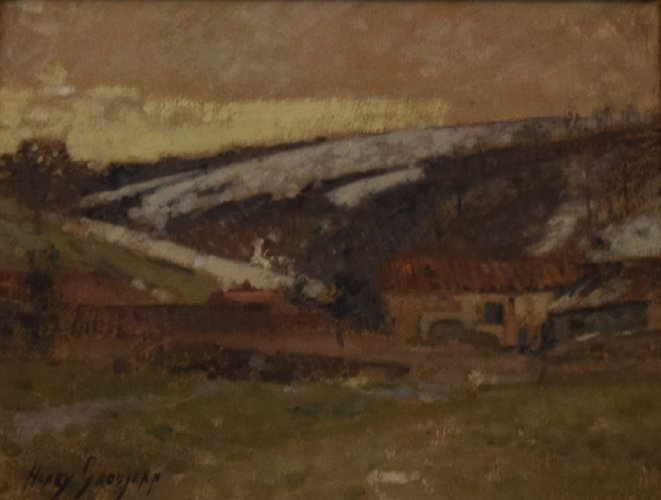Description:
Henry (Marie-Gustave-Henri) Grosjean (1864-1948) was a French painter. He studied at the Académie Julian. He exhibited at the Salon Société des Artistes Français and the Autumn Salon. Initially he mainly painted the outskirts of Paris, but thanks to his marriage he moved to the region of Overnia-Rhone-Alps. This was the area he most often painted, traveling in the company of his donkey, Pandora, who carried his painting equipment.
Description of the painting:
This small painting by the French landscape painter depicts a hilly, agricultural terrain covered in patches of snow. In the valley stands the buildings of a farm, almost blending in with the surroundings. The landscape portrays a fragment of a worn-out winter landscape, presenting muted, dirty greens and browns adorned by patches of white snow. Above the fields, the lemon yellow of a dim ochre sky enlivens the landscape, contrasting with a distant row of trees. The painting is treated very sketchily, almost as if it was a spontaneous recording of a scene noticed. Colours and shapes meld with each other. In many places the path of a dry brush is visible. Marie Gustave Henry Grosjean was born in Lorraine, in a poor family. His childhood was marked with many difficult experiences. His family, threatened by the Franco-Prussian conflict, moved to the outskirts of Paris. His father died quite soon, as well as one of his sisters, while the other one became paralysed. He was raised by his mother and aunt, who nurtured his sensitivity to music and painting.
At first, the artist mainly painted landscapes around Paris, but thanks to his marriage to a woman from Ain and the Jury department in the Overnia-Rodan-Alps region, these areas became the main object of his artistic interest. He was a loner, accompanied only by his donkey, Pandora, who carried his painting equipment, crossing the mountainous Alpine terrain to look for suitable frames for his works. Due to his constant moving, the artist usually painted small formats, less burdensome to transport.


